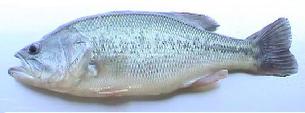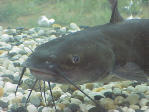Physical Features of Fish Fish Facts You can tell a lot about a fish from studying it closely. For example, you would expect a fish like crappie, with the mouth turned up and the eyes on top of the head, to feed above its own level. Channel catfish or sturgeon, on the other hand, you would expect to be bottom feeders. Bottom feeding fish like flounder or sturgeon also tend to be flattened. Fish like bluegill that are flattened side to side you would expect to inhabit weedy areas. Coloration Check Out The Stripes.... Coloration is another clue to where a fish lives. The vertical stripes on bream help them hide in weeds. Horizontal stripes on fish like striped bass help to break up their appearance in open water. Brightly colored fish inhabit clear water; drab-colored fish are usually found in muddy water. A good example of this is black crappie, which is usually found in clear water, and white crappie, which prefer dingy water. Bream found in a muddy pond will appear washed- out. Interestingly, blind catfish and bass (and maybe others) will turn almost black. Herbivores and Catfish.... Fish like grass carp that eat plant material (herbivores) have long intestines and a dark lining of the body cavity (peritoneum). Fish that eat other fish have short intestines and a light peritoneum. Look at the peritoneum of a flathead catfish; it is snow-white. Some people won't eat the belly meat of catfish, which is sometimes sold as "nuggets", because the peritoneum tends to have a strong taste. Removing the peritoneum will fix the problem. Types of Muscle Tissue Red & White There are also two types of muscle tissue in fish. White muscle is for speed over short distances. Ambush predators like bass have mostly white muscle. Red muscle is for sustained swimming. Almost all salt-water fish have a line of red muscle down each side for swimming in ocean currents. Fish found in rivers also will have red muscle tissue. The blue catfish is a good example of this. Red muscle has a strong taste and should be removed prior to cooking Next time you go fishing, look closely at your catch to see if you can detect features that give clues to the fish's habits. Playing detective can add another dimension to your outing. And take a kid with you. Children love to learn this way.
|


